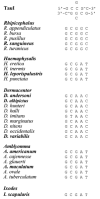Molecular differentiation of metastriate tick immatures
- PMID: 15682516
- PMCID: PMC4152316
- DOI: 10.1089/vbz.2004.4.334
Molecular differentiation of metastriate tick immatures
Abstract
Hard ticks, family Ixodidae, are divided into two groups, the Metastriata and the Prostriata, based on morphological differences. In the United States, there are four medically important genera of the Ixodidae: Ixodes, Amblyomma, Dermacentor, and Rhipicephalus. Ixodes is the only genus in and representative of the Prostriata, whereas the latter three genera are members of the Metastriata. All developmental stages of the Prostriata can be easily differentiated from the Metastriata using morphology. Similarly, the three Metastriate genera are highly identifiable as adults, yet as immatures, the discriminating characteristics can be difficult to use for differentiation, especially if the specimens are damaged or engorged with blood. All three Metastriate genera represent medically important vectors, thus accurate differentiation is necessary. To this end, we have developed a multiplexed-PCR diagnostic assay that, when combined with RFLP analysis will differentiate between the Metastriate genera--Amblyomma, Dermacentor, Rhipicephalus, and Haemaphysalis based on the length of the PCR amplicon and subsequent restriction digestion profile. The intended use for this diagnostic is to verify morphological identifications, especially of immatures, as well as to identify samples destroyed for molecular analysis, which will lead to more accurate field data as well as implication of vectors in disease transmission.
Figures




References
-
- Bishop FC, Hixson H. Biology and economic importance of the gulf coast tick. J Econ Entomol. 1936;29:1068–1076.
-
- Black WC, IV, Klompen JSH, Keirans JE. Phylogenetic relationships among tick subfamilies (Ixodidae: Argasidae) based on the 18S nuclear rDNA gene. Mol Phylogenet Evol. 1997;7:129–144. - PubMed
-
- Caporale DA, Rich SM, Spielman A, et al. Discriminating between Ixodes ticks by means of mitochondrial DNA sequences. Mol Phylogenet Evol. 1995;4:361–365. - PubMed
-
- Crampton A, McKay I, Barker S. Phylogeny of ticks (Ixodida) inferred from nuclear ribosomal DNA. Int J Parasitol. 1996;26:511–517. - PubMed
Publication types
MeSH terms
Substances
Grants and funding
LinkOut - more resources
Full Text Sources
Other Literature Sources

